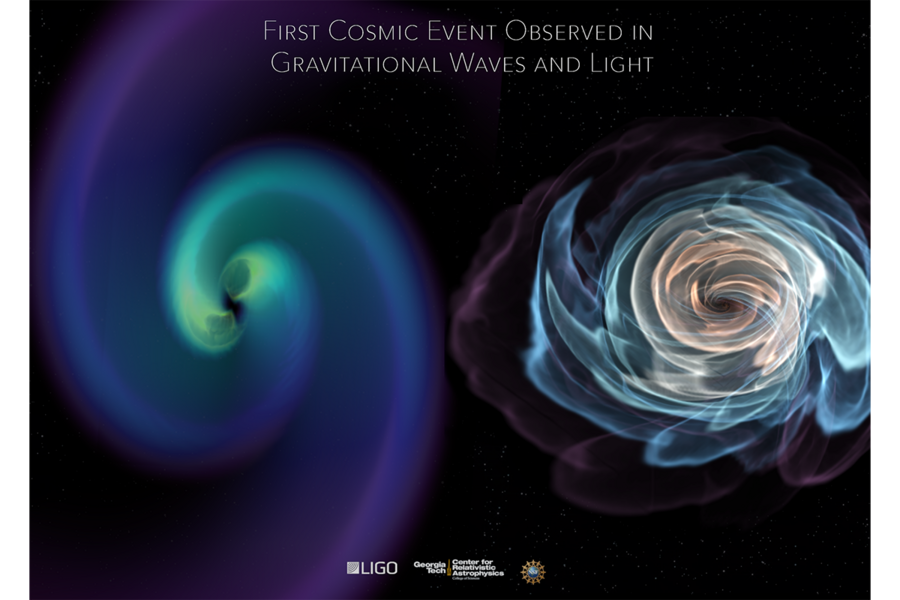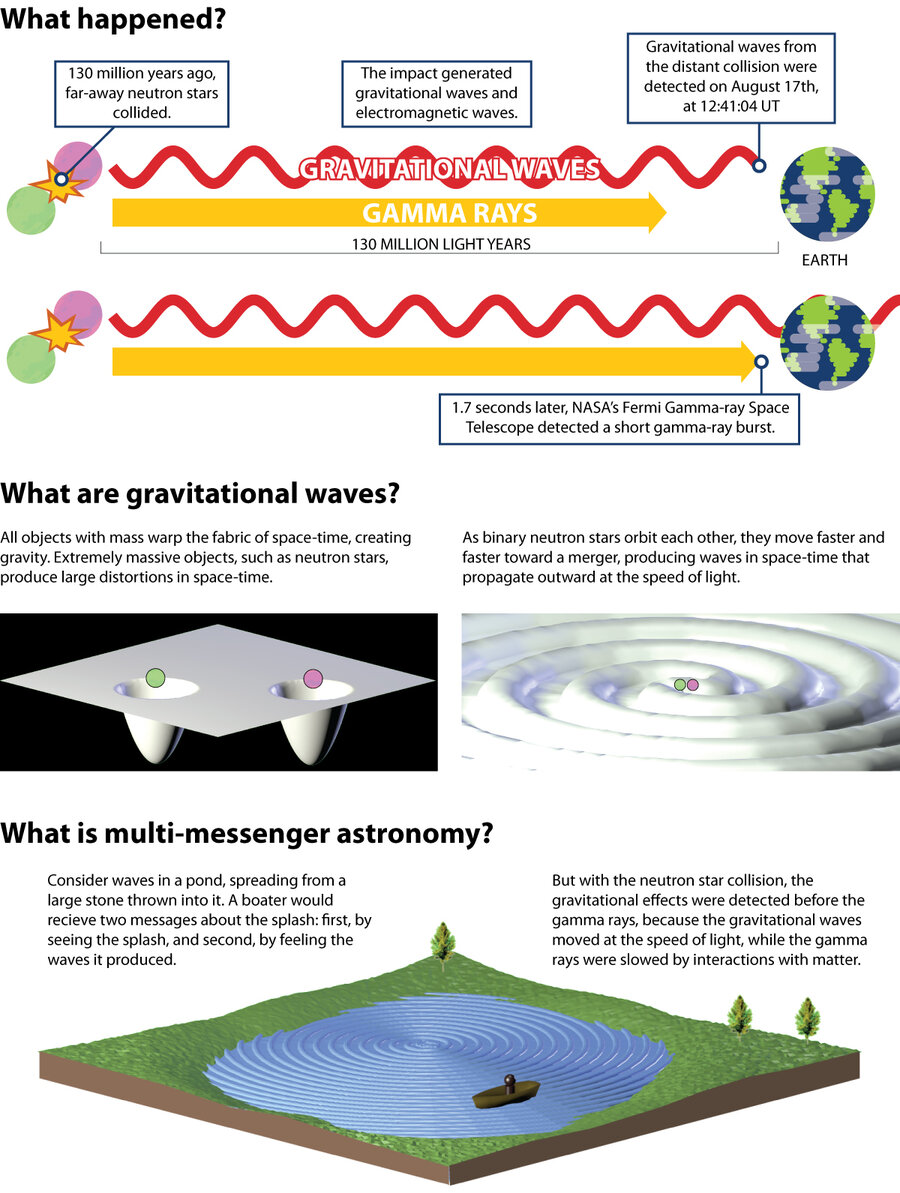Neutron star collision heralds arrival of a new era of astronomy
Loading...
Scientists are no longer just talking about it. After decades of theorizing, we're now actually in a new era of astronomy, defined by the capability to peer into the universe through multiple, distinct lenses. The first detections of gravitational waves opened the door further for this so-called multi-messenger astronomy. And now, with a highly publicized announcement Monday, astrophysicists have walked through that door.
Four times over the past two years, astronomers detected gravitational waves emanating from merging black holes. These detections were all made by scientists at the US-based Laser Interferometer Gravitational-Wave Observatory (LIGO). Its European counterpart, VIRGO, collaborated for the fourth detection. But with no light escaping black holes, astronomers using traditional telescopes – which view the universe in the electromagnetic spectrum – couldn't see anything.
The fifth detection was different; this time, the colliding bodies were visible. So astrophysicists at LIGO and VIRGO detected the motion from the collision, and astronomers saw the flash of light. Scientists are already using this multi-messenger detection to unravel long-standing mysteries about the universe, such as where heavy elements like gold, platinum, and uranium form.
"It is the Rosetta Stone for all of high-energy astrophysics," says Richard O'Shaughnessy, a theoretical gravitational wave astrophysicist and LIGO researcher at the Rochester Institute of Technology. "Superlatives understate the significance of this event, and I haven't figured out a way of conveying it, even to myself."
But what exactly is it that scientists are so excited about?
Some 130 million years ago, two neutron stars drawn into a gravitational dance with each other collided. This violent merger shook the fabric of space-time and sent fireworks of electromagnetic radiation out into the universe. On August 17, scientists detected the gravitational waves of this stellar event, and then less than 2 seconds later spotted a gamma-ray burst coming from the same location. Over the next few days, both Earth- and space-based telescopes picked up signals from across the electromagnetic spectrum emanating from this same event.
Neutron stars' incredible density made this event a particularly spectacular one. Neutron stars are more massive than the sun, but are just the size of a city. One teaspoon of material from a neutron star would weigh about 10 million tons. Because they are so dense, the gravity at the surface of a neutron star is billions of times stronger than the gravity at the surface of the Earth.
As the two super dense bodies spiral in toward each other, their masses produce very strong gravitational interactions. And because the neutron stars are so small, they can get very close to each other before merging, twirling around each other faster and faster as they approach each other. As they whip around, the gravitational fields of the pair of neutron stars interact, forming gravitational waves with a high-enough frequency that they can be felt on Earth.
But what are gravitational waves?
Ask a physicist and they'll tell you that gravitational waves are ripples in the fabric of space time. But what does that actually mean? Shane Larson, an astronomer at Northwestern University and a member of the LIGO Scientific Collaboration, says the explanation hinges on the law that nothing can travel faster than the speed of light.
According to Einstein's General Theory of Relativity, every object with mass bends space-time to some degree, and the greater the mass, the greater the distortion. This model explains why moons orbit planets and planets orbit the sun.
When an object moves – say, two neutron stars merge – gravity must necessarily change. And somehow information about that change in gravity has to get from that object to the other objects that experience its gravity. But because it can only travel as quickly as the finite speed of light, and that makes it impossible for things to react simultaneously, Dr. O'Shaughnessy explains, those gravitational changes propagate outward through the universe.
And this happens as quickly as it possibly could. In fact, the gravitational waves of the neutron star merger were detected on Earth first, even before the gamma ray burst.
"General relativity predicts that gravitational waves should travel at the speed of light," Dr. Larson says. That's because gravitational waves can travel through matter without slowing down.
Light, by contrast, interacts with the matter it encounters. It is scattered by matter, absorbed by matter, and reemitted by matter. In a collision of super dense neutron stars, Larson says, "the material at the core of the event is still so dense that the light can't get out as quickly as the gravitational waves … The photons and everything have to work their way out. And the energy that's energizing the matter has to work its way out to the outer layers where the photons that are emitted can reach us."
Astrophysicists have long looked for neutron star collisions, as scientists knew the celestial bodies existed in binary systems. Astronomers had spotted short gamma-ray bursts before that they thought were the signal of such a merger, but they couldn't be sure until the gravitational wave detections combined with the electromagnetic observations were made in August.
"This has been the holy grail of high-energy astrophysics," O'Shaughnessy says.
Gravitational waves and the photons of electromagnetic radiation are not the only messengers from the universe. Astronomers have also used neutrino and cosmic ray observations to learn about the universe. But with the addition of gravitational waves, scientists will now be able to develop a more complete understanding of the cosmos.
Scientists are thrilled to find out what mysteries multi-messenger astronomy might unravel now that gravitational waves have been added to the toolbox, but they're also patting themselves and their colleagues on the backs.
"Really we should all just be outrageously proud and flabbergasted that we are capable of building instruments to make these measurements," Larson says. And, he says, this wouldn't be possible without the thousands of scientists, engineers, construction workers, telecommunications workers, and others who have collaborated to build the laser interferometers.
"The fact that we can all get together and make this instrument should make all of us look at every problem that we face and go, 'Wow, why can't we solve that problem?' " Larson says. "Science is a uniquely human endeavor. As far as I know, my cats are not down in the basement building gravitational-wave detectors."
[Editor's note: This story has been updated.]









